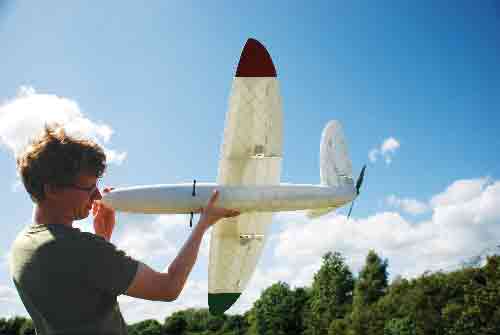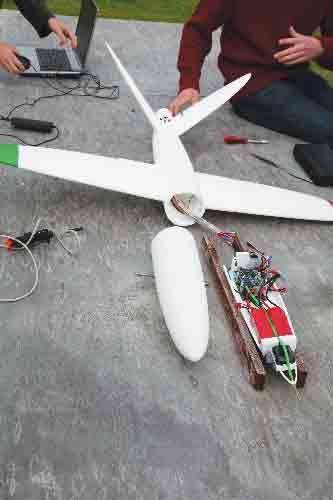3D Printing Takes to the Air
Laser sintering is used to design and build what's being hailed as the first 3D-printed unmanned airplane.
Latest News
March 1, 2012
By Susan Smith
Reminiscent of model airplanes with their snap-together features, the Southampton University Laser Sintered Aircraft, or SULSA, is the first of its kind: a 3D printed airplane created using an EOS Eosint P730 nylon laser sintering machine. SULSA is part of the EPSRC-funded Decision Environments for Complex Designs (DECODE) project, which consists of a team of students and staff of the University of Southampton who design, build and fly sub-20kg state-of-the-art unmanned air vehicles (UAVs) outfitted with full autonomous control systems and on-board cameras. These include morphing wings and tiperon control surfaces.

The aircraft has a pusher engine, v-tail design, elliptical wing planform and
five printed nylon parts in the airframe.
Currently, they are using manufacturing techniques such as laser sintering to demonstrate their use in the design of UAVs. These SULSA aircraft are small, fly and have “useful payload,” notes A.J. Keane, professor of Computation Engineering at University of Southampton and a Fellow of the Royal Academy of Engineering (FREng). He and Jim Scanlan, professor of Aerospace Design, are both project leads from the Computational Engineering and Design Research group.
“I guess it’s more than a model, though not being made in a production fashion, since we are not a commercial operator (yet),” Keane says.
The entire structure is 3D printed from a SolidWorks 3D CAD model, with conventional servos, batteries, avionics, motor and propeller that clip into place without screws. The design process was streamlined with complete optimization, design and manufacturing work flow.
Designed by the University of Southampton, the 3D printing additive layer manufacturing specialist company 3T RPD Ltd., based in Berkshire, assisted in the process. Skycircuits created the autopilot capability. EOS Eosint P730 was chosen because there are only two companies who offer nylon sintering, and the aircraft needed the strength of nylon.
In addition to research projects like this one from the University of Southampton, 3T RPD applies its technology to various projects, such as creating specialist aerospace components, medical implants and architectural design elements for the construction industry.
Snappy Structure
The aircraft boasts a four-part structure, including main fuselage, rudder fins, nose cone and two outer wings. The aircraft itself has a pusher engine, v-tail design and elliptical wing form. The fifth nylon part is the instrument tray that clips inside the main fuselage.
All the fasteners are printed in the nylon, with no bolts, screws or nuts. Hinges are also 3D printed, and all hinges and parts are printed in place.
All the equipment is clipped into place including four servos, the engine, and the equipment tray that has clips for and houses all the additional equipment, which includes two batteries, avionics and the autopilot. The front fuselage is attached using a bayonet.
The maximum engine power for the aircraft is 400 w. Cruise range is nearly 28 miles at 38 knots. The electric-powered aircraft has a 6-ft., 6-in. wingspan and can fly at a top speed of nearly 100 mph. When it’s in cruise mode, it’s almost silent. It is also equipped with a miniature autopilot. The weight of the plastic parts is less than 5 lbs. The aircraft employs a catapult launch with a belly landing.
 All equipment is clipped into place. |
“Aerodynamicists have, for decades, known that elliptical wings offer drag benefits,” Scanlan points out. “But laser sintering removes the manufacturing constraint associated with shape complexity—and in the SULSA aircraft, there is no cost penalty in using an elliptical shape.”
Scanlan says that the laser sintering process is so flexible, it allows the design team to explore ideas that would have been extremely expensive using traditional manufacturing methods. One of these ideas involves the use of a geodetic structure, which is stiff and lightweight, but also complex. To create this type of structure traditionally would require numerous, individually constructed parts that would have to be fastened together—at great expense. This type of structure was initially developed by Barnes Wallis, and used on the Vickers Wellington bomber that first flew in 1936.
Because the design is parametric, it can be stretched and resized. Although this design is small, it can be made larger to accommodate larger aircraft designs.
“This could revolutionize the economics of aircraft design,” Keane predicts. “The cost of structural design complexity is effectively zero.”
Keane adds that because there are no tooling costs and you can print when you need to, mass customization will be not only possible, but desirable. Scanlan agrees.
The only time-consuming element of the process is the powder cleaning, but otherwise designs can be upgraded and spare parts printed in 96 hours or less.
When the aircraft goes into production, the team plans to combine 3D printing with numerically cut foam techniques it’s been pioneering to make large wings. The two materials are linked with carbon fiber tubes as spars.
Keane and Scanlan say that they see observation studies such as for shorelines, oceanography or forests as potential uses for the aircraft. Farming also will be a big user, they predict, “once air regulations catch up.”
Susan Smith is a contributing editor for Desktop Engineering magazine. She has been an editor and writer for the technology industry for more than 15 years and resides in Santa Fe, NM. Send e-mail about this article to [email protected].
MORE INFO
Subscribe to our FREE magazine, FREE email newsletters or both!
Latest News
About the Author
DE’s editors contribute news and new product announcements to Digital Engineering.
Press releases may be sent to them via [email protected].






